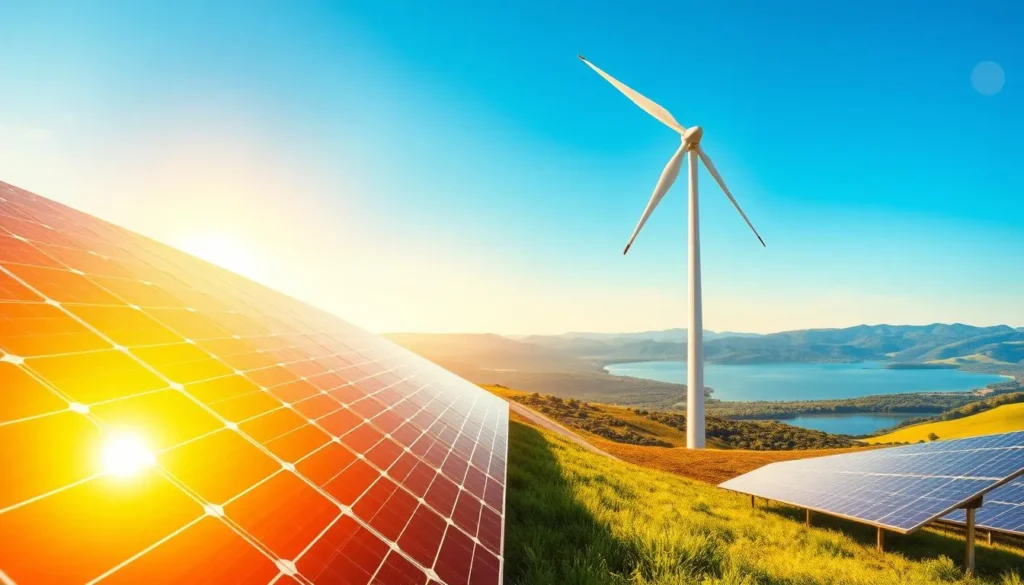Renewable energy is that which is obtained from natural sources such as sunlight, wind, water, and the earth’s heat, and these sources are constantly being regenerated.
The world is currently on the path to environmentally friendly energy. In the coming years, especially by 2040, the demand for electricity and fuel is expected to increase by more than 30%. That is why it is the need of the hour that we adopt sources that are not only safe but also naturally clean.

Rapid climate change has driven the world towards clean energy. Most countries are now investing heavily in solar, wind, and other natural power.
Key Takeaway
- Using renewable energy is crucial to reducing dependence on old fuels.
Major Renewable Energy Sources and Their Applications
To understand the coming times, it is important that we understand the major sources of clean energy. These sources are very important for a clean and better future. By understanding them, we can make better decisions about energy use.
1. Solar Energy
Source: Sunlight
How it works:
This system works in such a way that some devices convert sunlight directly into electricity, while some methods use the sun’s heat to heat water or oil to produce heat or electricity.
Applications
- Solar panels mounted on the roofs of homes and commercial buildings are an efficient way to generate electricity
- Large areas where electricity is generated by installing many solar panels
- Heaters and stoves that use the sun’s heat to heat water or cook food
- Providing solar power in rural areas where there is no electricity line
2. Wind Energy
Sources:
When there is a difference in pressure in the atmosphere, it causes air to move.
How it works:
This system works by using the power of the wind to spin fans, which creates movement, and then this movement is converted into electricity.
Applications
- Wind power plants installed on land and at sea
- Systems for small areas that generate electricity from both the sun and the wind
- A means of delivering electricity to remote or agricultural areas
3. Hydropower
Sources:
Flowing or falling water.
How it works:
When water flows at speed, it spins the blades, which generate electricity through a machine.
Applications
- Very large dams that store a lot of water and generate electricity, such as the Three Gorges Dam in China
- Small hydropower systems play an important role in providing electricity to rural areas
- To balance the power system, water is pumped up and then pumped down again to generate electricity
4. Biomass Energy
Source:
Natural materials such as wood, crop residues, and animal waste are useful for energy.
How it works:
Biomass is either burned to generate heat or electricity, or it is converted into fuels such as biogas and biodiesel.
Applications
- In villages, it is used for cooking and keeping the house warm
- Biogas plants help generate electricity or heat by using waste.
- Vehicles and generators that run on biofuel
5. Geothermal Energy
Source:
Natural heat emanating from within the earth
How it works:
Hot water or steam collected underground spins a turbine or directly provides heat.
Applications
- Geothermal power plants, such as those in Iceland and the Philippines
- Systems designed to heat an entire area
- Methods for heating greenhouses and fish farms
6. Tidal & Wave energy
Source:
The movement of ocean waves and tides
How it works:
The energy from ocean waves or tides is converted into electricity by underwater devices.
Applications
- Tidal dams and underwater fans
- Offshore power generators that harness the power of waves
- This system is still in its early stages but could prove beneficial for island nations
7. Hydrogen (From Renewable Sources)
Sources:
The process of extracting hydrogen by splitting water with clean energy
How it works:
Water is separated to produce hydrogen and oxygen, then the hydrogen is stored and used as a clean fuel.
Applications
- Fuel cells are used to power vehicles and provide backup power
- Also used in factories to produce heat and chemicals
- To store clean energy that is sometimes unavailable
The Compelling Advantages of Renewable Energy
These are the compelling advantages of Renewable Energy:
Environmental Benefits: Reducing Carbon Footprint
Utilizing renewable energy reduces the burden of pollution on the earth. When we reduce the use of old fuels, fewer gases are also emitted that harm the environment. This process helps to control climate change.
Electricity generated from sources such as the sun, wind, and water does not pollute the atmosphere. This energy is produced in a way that does not produce any harmful gases.

Economic Advantages: Job Creation and Cost Savings
Renewable energy also benefits the economy. This sector provides jobs for people to do various tasks such as building, installing, and maintaining things. Over time, technology is becoming cheaper, which is reducing costs.
Energy Independence: Reinforcing National Security
If we use clean energy produced within our country, it can make the country more independent and secure. When we import less fuel, the benefit is that prices also change less and the system remains more stable.
Renewable energy is not only good for the environment; it is also a strong step for the economy and national policy. As the world moves towards sustainable sources, these benefits are becoming even more important.
Observations have shown that renewable energy systems have practical benefits. These points are based on current scientific facts and policy reports, not personal opinions. This article relies on researched data and reliable references.
Successful renewable energy projects worldwide: A research review
United States (California)
According to report published by Information Energy Administration, California is the leader in solar energy in the United States, with more than 40 gigawatts of solar systems installed by 2023.
This was made possible by net metering, state incentives, and policies, which resulted in California meeting its renewable energy goals ahead of schedule.
Pakistan
According to reports published by en.wikipedia.org and time.com, the Quaid-e-Azam Solar Park in Bahawalpur, Punjab, was planned to be scaled up to 1,000 MW but is currently operating at 400 MW.
The project, spread over an area of about 8 square kilometers, has installed around 1.6 million solar panels and, by 2020, had supplied more than 2 billion kilowatt hours of electricity to the national grid.
Morocco
According to article published by World Bank Group, the Noor-Solar Complex near Ouarzazate is the world’s largest concentrated solar project, with a total capacity of around 580 MW (including both CSP and PV).
Its first phase, with 160 MW, began operation in 2016, with subsequent phases completed in 2018. The plant includes molten salt storage to preserve power even after sunset.
Denmark
According to reports published by Vattenfall and OffshoreWIND.bizz, Horns Reef 3, located in the North Sea, is a 407 MW offshore wind farm, built by Vattenfall and commissioned in late 2018. The project has 49 turbines, capable of supplying electricity to approximately 425,000 Danish homes.
It set a new precedent for low-cost wind power generation, with starting prices of just €0.103 per kWh, saving an estimated €295 million over the subsidy period. This enabled Denmark to generate about 47% of its electricity from wind in 2019.
Germany
According to article published by Fraunhofer, Germany’s “Energiewende” plan is switching from coal and nuclear to green energy. In 2023, almost 60% of its electricity came from renewables like wind and solar.


